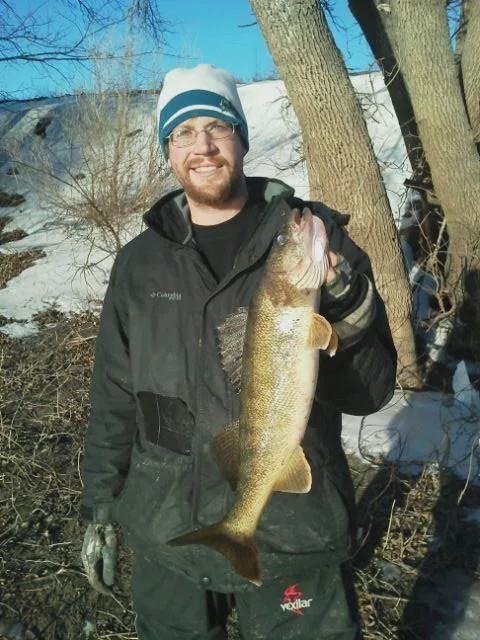
Anglers can find walleyes in the runs below lowhead dams, like this 25 incher caught by the author’s brother downstream from the Little Dam on the Sheyenne River in Valley City, ND. Simonson Photo.
By Nick Simonson
Whether spring comes late like last year, or is looking to arrive a bit early like this year, targeting some key areas for walleyes whenever things open up on a favorite river will help increase your odds of success at the chilly start to the openwater season. Utilizing dams and other obstructions, exploring areas below them, and knowing what walleyes are looking for this time of year will increase the odds of connecting with more frequent bites and put more fish on those first stringers of the season, when fishing from shore.
Dam Good Spring Fishing
While the lowhead dam is an endangered structure of sorts, many of them still exist along the smaller rivers of the upper Midwest. Where these outdated hazards to both human well-being and to the migratory habits of fish have been replaced, navigable rock riffles still provide some of the same benefits. Among them are the oxygenation of water, the roiling of detritus and other bottom items that draw in a unique food web, and with rock deposits, wings, and other unique elements to their construction, many places for fish to stage, rest, and ambush prey ahead of the spawning stretch to come later this spring.
As a block in the flow, fish are forced to congregate below a lowhead dam, as they’re unable to move upstream unless spring waters get really high. Even the navigable rock-riffle replacements for last century’s lowheads can slow the upstream migration of fish in the spring. Here, walleyes will stack up in current seams, sit in eddies and lie in wait behind rocks, timber and other obstructions that break the flow. Explore everything from where the water foams to the bottom of the pool below each dam of any type to connect with fish, as these are typically the spaces that open from winter’s ice first.
Look Downstream
As that ice breaks up even more, don’t be surprised to find fish early on in the openwater stretch well downstream from dams. Oftentimes, the next hole down from the main run created after water goes over a dam will hold fish, and sometimes even the next scour will be the one harboring walleyes. With a bit of exploration, working the front and back lip of those deeper portions of a river downstream from a dam will produce new and perhaps better spots, especially when fish aren’t terribly concerned about making a spawning run just yet.
These areas are easily identified by the calmer surface above them, and the riffles in front of them. Typically, with a properly weighted jig, one can pick up the deeper grade of a hole or a scour and then determine the depth or location within each one where fish are holding. Don’t forget to cast to all sides to figure out the dimensions of the deeper stretch and where fish are relating to it or the structure within it.
Slow to Start
Finally, once deeper holding spaces and shallower feeding stretches are identified in early spring, work each portion methodically to pick up fish. Use the lightest jig possible which allows contact with the bottom, and don’t shy away from live bait such as fathead minnows, including some smaller ones to present a compact package for fish that might not be in the hungriest of moods. Work each jig downstream with the current, bumping bottom to detect changes in composition from gravel to mud, or from chunk rock to gravel.
Remember that early spring water isn’t much warmer than 39 degrees, though with each day and with brighter sun, inflowing meltwater warms faster and those temperatures can spike later in the afternoon, triggering more aggressive activity from early spring walleyes as evening and it’s low light conditions set in over the warming flow. In either case, presenting jigs slowly and methodically will help you catch more fish in those areas where the water first opens in spring.
Target dams, Texas crossings and those newer navigable rock-riffles for walleyes this spring, and eye up those areas downstream from them as the ice gives way. Remember to go slow in your presentation, using the right-sized jig and minnow combination to trigger bites from wary walleyes.
